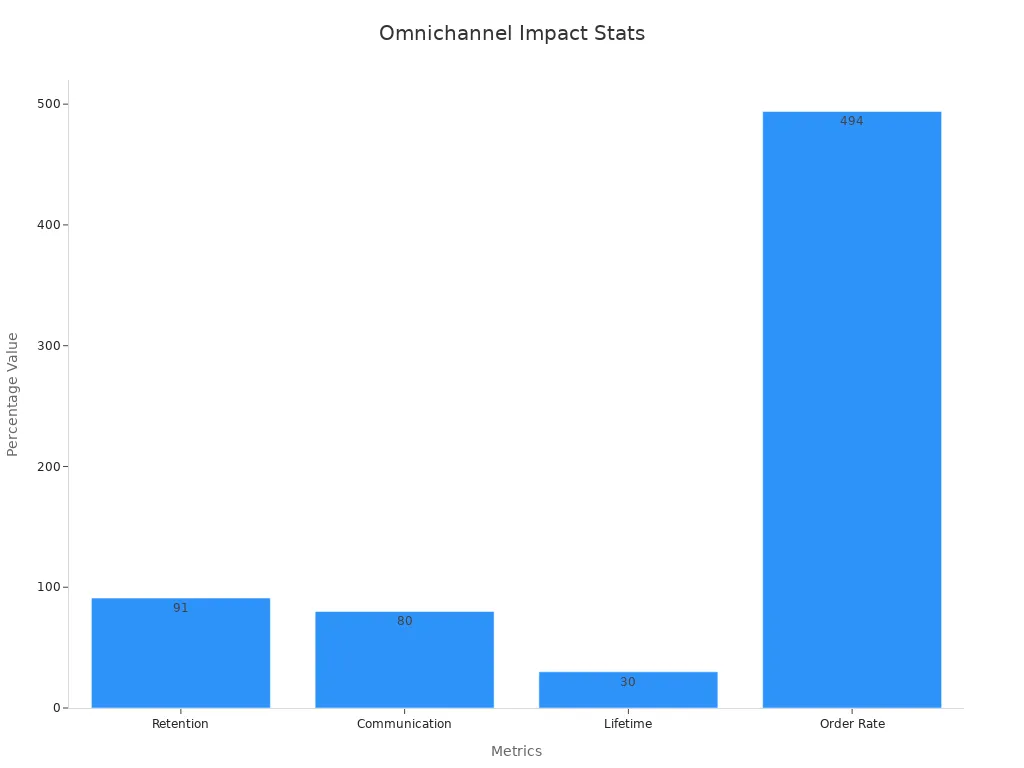Comprehensive Guide to Omnichannel Customer Service Tools

Omnichannel customer service tools unify communication channels to create seamless interactions. These tools help you meet rising expectations for consistent experiences across platforms. Over 90% of customers demand this consistency, yet many businesses struggle to deliver it. By integrating channels, you can retain more customers and improve satisfaction. Chatbots, for instance, handle up to 70% of inquiries, freeing agents for complex tasks. Companies investing in customer experience often see significant returns, with gains averaging $775 million over three years. Tools like Sobot’s omnichannel customer service software empower you to enhance efficiency and build lasting loyalty.
Understanding Omnichannel Customer Service Software
Definition and Core Purpose
Omnichannel customer service software integrates all communication channels into a single platform. This approach ensures that your customers experience seamless interactions, no matter how they choose to connect with your business. Whether they reach out via email, social media, or live chat, the software keeps their information and conversation history unified. This eliminates the frustration of repeating details and creates a consistent experience.
The core purpose of omnichannel customer service is to enhance satisfaction and loyalty. By allowing smooth transitions between channels, you can meet modern expectations for convenience. For example, a customer might start a conversation on live chat and later continue it over email without losing context. This strategy not only improves customer retention but also reduces operational costs by streamlining processes.
| Aspect | Description |
|---|---|
| Definition | Omnichannel customer service integrates various communication channels to provide a seamless customer experience. |
| Core Purpose | It aims to enhance customer satisfaction by allowing fluid transitions between channels, ensuring that customers do not have to repeat information. |
| Benefits | Reduces operational costs, accelerates issue resolution, and increases revenue through personalized customer interactions. |
Key Differences Between Omnichannel and Multichannel Approaches
At first glance, omnichannel and multichannel support may seem similar, but they differ significantly. Multichannel support involves offering multiple communication channels, such as phone, email, and social media. However, these channels often operate independently, leading to fragmented customer experiences.
Omnichannel support, on the other hand, connects all channels into a unified system. This integration ensures that your customers enjoy a consistent and personalized experience across platforms. For instance, if a customer contacts you through social media and later calls your support team, omnichannel software ensures that all previous interactions are accessible to the agent. This reduces customer effort and enhances satisfaction.
- Multichannel Support: Channels operate independently, often causing disjointed experiences.
- Omnichannel Support: Channels are interconnected, providing a seamless and unified experience.
Applications in Customer Support and Success
Omnichannel customer service software plays a vital role in improving customer support and success. It allows you to manage interactions across various platforms efficiently. For example, businesses like Opay have used omnichannel solutions to integrate social media, email, and voice channels. This approach helped them increase customer satisfaction from 60% to 90% while reducing costs by 20%.
The software also supports proactive engagement. Features like AI-driven chatbots handle repetitive queries, freeing your agents to focus on complex issues. In addition, analytics tools provide insights into customer behavior, enabling you to optimize your strategies. Whether you’re in retail, financial services, or gaming, omnichannel customer service platforms can transform your operations and boost customer loyalty.
- 40 Case Studies Exploring Customer Service: Showcases how organizations enhance satisfaction and service delivery through software solutions.
- Successful SaaS Applications: Highlights the scalability and user-friendly design of platforms like Zendesk.
- Cisco Customer Stories: Demonstrates how technology improves application performance and customer service.
Key Features and Benefits of Omnichannel Customer Service Tools

Unified Customer Interaction Management
Managing customer interactions across multiple channels can be challenging. Omnichannel customer service software simplifies this by unifying all communication channels into a single platform. This ensures that your team has access to complete customer histories, regardless of the channel used. For example, if a customer starts a conversation on social media and later switches to email, the software keeps all interactions connected. This eliminates the need for customers to repeat themselves, saving time and reducing frustration.
Unified customer interaction management also improves your team’s efficiency. Agents can quickly access relevant information, allowing them to resolve issues faster. According to Dynamics 365 Customer Service documentation, this feature enhances productivity and ensures consistent service quality. By streamlining workflows, you can focus on delivering personalized experiences that build loyalty.
- Key Benefits:
- Seamless transitions between channels.
- Faster issue resolution.
- Improved customer satisfaction and loyalty.
Real-Time Data Synchronization Across Channels
Real-time data synchronization is a game-changer for businesses. It ensures that updates made on one channel are instantly reflected across all others. This feature is particularly valuable in industries like banking and healthcare, where accurate and timely information is critical. For instance, in banking, real-time synchronization prevents errors by updating account details immediately. In healthcare, it ensures that doctors have access to the latest patient records, improving care quality.
| Benefit | Description |
|---|---|
| Faster Decision-Making | Real-time data access enables quicker, informed decisions by executives. |
| Enhanced Efficiency | Reduces the administrative burden of managing multiple data sources, leading to smoother operations. |
| Risk Management | Minimizes potential data breaches by ensuring consistent security protocols across all data points. |
| Customer Satisfaction | Improves client interactions through accurate and timely information, leading to higher satisfaction and loyalty. |
This synchronization also supports better collaboration within your team. Everyone stays on the same page, reducing errors and enhancing overall efficiency. By integrating real-time data synchronization into your operations, you can deliver a seamless experience that meets modern customer expectations.
Enhanced Customer Experience and Retention
Omnichannel customer service tools significantly enhance customer experience and retention. They allow you to provide personalized and seamless interactions, which 80% of customers prefer. Businesses using omnichannel strategies report a 91% higher year-over-year retention rate compared to those that don’t. Additionally, omnichannel shoppers have a 30% higher lifetime value than single-channel shoppers.

These tools also improve customer engagement by offering consistent communication across platforms. For example, Sobot’s omnichannel customer service software integrates AI-driven chatbots and analytics, enabling you to anticipate customer needs and deliver proactive support. This approach not only boosts satisfaction but also strengthens loyalty, ensuring long-term success for your business.
Improved Team Collaboration and Productivity
Omnichannel customer service tools do more than just improve customer interactions. They also transform how your team collaborates and performs. By centralizing communication channels, these tools ensure that everyone on your team has access to the same information. This eliminates confusion and reduces the chances of miscommunication. For example, when agents can view a customer’s complete interaction history, they can work together more effectively to resolve issues.
Collaboration becomes seamless when your team uses a unified platform. Features like shared workspaces and real-time updates allow employees to stay aligned, even when working remotely. According to industry reports, over 85% of employees believe that poor communication leads to workplace failures. Omnichannel tools address this by providing a single source of truth for your team. This clarity boosts productivity and ensures that tasks are completed efficiently.
Video collaboration features, often integrated into omnichannel platforms, further enhance teamwork. Among remote employees, 87% say video collaboration helps them feel more connected to their colleagues. This connection fosters a sense of unity and improves overall performance. Additionally, businesses report that video tools increase productivity by as much as 94%.
These tools also streamline workflows by automating repetitive tasks. When agents spend less time on routine activities, they can focus on more meaningful work. This not only improves job satisfaction but also enhances the quality of service your customers receive. By adopting omnichannel solutions, you empower your team to work smarter, not harder.
💡 Tip: Encourage your team to explore all the features of your omnichannel platform. Familiarity with the tools can lead to even greater productivity gains.
Comparison of Top Omnichannel Customer Service Platforms

Overview of Leading Platforms
Choosing the best omnichannel customer service platforms can transform how you interact with customers. These tools unify communication channels, making it easier to deliver seamless experiences. Popular platforms include Zendesk, Salesforce Service Cloud, and Sobot. Each offers unique features tailored to different business needs.
- Zendesk: Known for its user-friendly interface, Zendesk provides tools for ticketing, live chat, and analytics. It supports businesses of all sizes.
- Salesforce Service Cloud: This platform integrates customer data with AI-driven insights, helping you personalize interactions.
- Sobot: Sobot stands out with its all-in-one omnichannel solution. It combines voice, email, chat, and social media into a unified workspace. Its AI-powered features enhance efficiency and customer satisfaction.
These platforms help manage interactions across multiple channels, ensuring consistent service quality. Whether you need basic ticketing or advanced automation, you’ll find options that fit your requirements.
Features Comparison Table
Here’s a quick comparison of features offered by leading customer service platforms:
| Platform Name | Description | Features |
|---|---|---|
| Zendesk | Cloud-based services for customer service agents | Ticketing, live chat, analytics, and routing |
| Salesforce Service Cloud | AI-driven insights for personalized service | Customer data integration, automation |
| Sobot | Unified omnichannel solution | Voice, email, chat, social media, AI tools |
This table highlights how each platform caters to different needs. For example, Zendesk excels in ticketing, while Sobot offers a comprehensive omnichannel approach.
Pricing Models and Cost Analysis
Understanding pricing models helps you choose the best customer service software for your budget. Platforms typically offer tiered plans based on features and user count. Here’s an overview:
| Plan Type | Average Price | Common Features |
|---|---|---|
| Free Plan | $0 | Basic ticket management, email support, knowledge base access |
| Personal Plan | $5-$25/user/month | Live chat, basic automation, limited analytics |
| Business Plan | $30-$60/user/month | Advanced ticketing, multi-channel support, dashboards |
| Enterprise Plan | $70-$150/user/month | Comprehensive automation, full analytics suite, personalized support |
For example, Zendesk’s Suite Team plan starts at $55 per agent monthly, while its Suite Enterprise plan requires custom pricing. Sobot offers flexible pricing tailored to your business needs, ensuring scalability and cost-effectiveness.
💡 Tip: Evaluate your business size and goals before selecting a plan. This ensures you invest in features that deliver the highest ROI.
Why Sobot Stands Out in Omnichannel Customer Support

Sobot excels in omnichannel customer support by offering a unified platform that simplifies communication and enhances efficiency. Its solutions integrate advanced technologies like AI and automation, enabling you to deliver seamless and personalized experiences across all channels. Whether your customers reach out via email, social media, or voice calls, Sobot ensures every interaction is connected and consistent.
One of Sobot’s standout features is its AI-powered Voicebot, which recognizes customer intent and provides intelligent responses. This reduces the workload on your agents, allowing them to focus on complex issues. Additionally, Sobot’s unified workspace consolidates customer data, giving your team instant access to interaction histories. This eliminates the need for customers to repeat themselves, saving time and improving satisfaction.
Sobot’s omnichannel solutions also include real-time data synchronization, ensuring updates made on one channel reflect across all others. For example, if a customer starts a conversation on live chat and later switches to email, your agents can pick up right where the conversation left off. This feature not only enhances the customer experience but also boosts your team’s productivity.
To achieve success with Sobot, follow these steps:
- Define your goals, such as reducing response times or increasing first-call resolutions.
- Choose the right tools, like Sobot’s CRM integrations and AI-driven features.
- Train your team to use the platform effectively.
- Measure key performance indicators (KPIs) like average handling time and customer satisfaction scores to optimize your operations.
Sobot’s impact is evident in real-world applications. For instance, Opay, a financial service platform, used Sobot’s omnichannel solution to integrate social media, email, and voice channels. This resulted in a 90% customer satisfaction rate, a 20% cost reduction, and a 17% increase in conversion rates. These results demonstrate how Sobot helps businesses like yours achieve operational excellence and customer loyalty.
By choosing Sobot, you gain access to a reliable, scalable, and user-friendly platform that transforms your customer interactions. Its innovative features and proven results make it a leader in omnichannel customer support.
Best Practices for Using Omnichannel Customer Service Software
Training Your Team for Effective Use
Proper training is essential for maximizing the benefits of omnichannel customer service software. Equip your team with the skills to handle various communication channels effectively. Start by training agents on each channel, such as live chat, email, and social media. Teach them how to maintain consistent messaging and practice empathy during interactions. This ensures customers feel valued and understood.
Focus on cross-channel communication skills. For example, train your team to transition conversations seamlessly between platforms without losing context. Provide coaching on the software’s functionalities, including automation tools and analytics. Cisco’s approach to training, which emphasized collaboration and data-informed service delivery, resulted in a 20% increase in customer satisfaction. You can achieve similar results by implementing comprehensive training programs.
Encourage your team to use collaborative tools within the software. These tools improve teamwork and ensure everyone stays aligned. Regularly update training materials to reflect new features or channels. By investing in training, you empower your team to deliver exceptional customer experiences.
Integrating Tools with Existing Systems
Integrating omnichannel tools with your current systems ensures smooth operations. Begin by evaluating the compatibility of your existing platforms. For instance, check if your CRM or order management system can connect with the new software. This step eliminates data silos and ensures all departments work from a unified source.
Engage consultants with expertise in customer communications management to streamline the integration process. They can assess workflows and recommend improvements. For example, LaFleur successfully integrated analytics tools to transform data into actionable insights, enhancing customer engagement. Similarly, ensure your tools support real-time data synchronization to provide accurate and timely information across channels.
Automate processes wherever possible. For instance, use the software to automate ticket creation or route inquiries to the right agent. This reduces manual effort and minimizes errors. By prioritizing seamless integrations, you create a cohesive system that enhances both efficiency and customer satisfaction.
Monitoring and Optimizing Performance
Monitoring performance is crucial for maintaining the effectiveness of your omnichannel customer service tools. Use observability techniques like logs and metrics to gain insights into system behavior. For example, track response times and resolution rates to identify areas for improvement. Capacity planning helps you forecast demand and scale resources accordingly, ensuring consistent service during peak periods.
Implement load balancing to distribute workloads evenly. This prevents bottlenecks and ensures smooth operations. Caching techniques can also improve performance by storing frequently accessed data for faster retrieval. Automated scaling adjusts resources based on demand, keeping your system efficient.
Regularly review key performance indicators (KPIs) like customer satisfaction scores and first-contact resolution rates. Use these insights to optimize workflows and improve service quality. By continuously monitoring and refining your processes, you enhance customer retention and ensure long-term success.
Ensuring Consistent Customer Experience Across Channels
Delivering a consistent customer experience across channels is essential for building trust and loyalty. Customers expect seamless interactions, whether they contact you via email, social media, or phone. To meet these expectations, you need to implement strategies that unify your communication efforts.
Start by syncing customer data across all channels. This ensures your team has a complete view of each customer’s history, preferences, and past interactions. For example, if a customer begins a conversation on live chat and later calls your support team, agents can access the full context without asking repetitive questions. This approach saves time and enhances satisfaction.
Standardizing processes is another key step. Establish clear guidelines for handling inquiries and set measurable KPIs, such as response times and resolution rates. For instance, ensure every call is answered within a specific timeframe to maintain uniform service quality. Use technology solutions like CRM systems to centralize data and enable personalized interactions across channels.
To improve team collaboration, create clear communication channels within your organization. Equip your team with tools that allow them to share updates and insights in real time. This reduces errors and ensures everyone stays aligned. Additionally, enable cross-channel continuity so customers can transition seamlessly between platforms without losing context.
💡 Tip: Regularly review your processes and KPIs to identify areas for improvement. Continuous optimization helps you adapt to changing customer needs and expectations.
By adopting these strategies, you can provide a consistent omnichannel experience that meets modern customer demands. This not only improves satisfaction but also strengthens loyalty, ensuring long-term success for your business.
How to Choose the Right Omnichannel Customer Service Platform
Assessing Your Business Needs
Start by identifying your business goals and challenges. Consider the volume of customer interactions and the channels they prefer. For example, if most of your customers use social media, prioritize platforms that excel in social media integration. Tools like SurveyMonkey Genius or Nicereply can help you gather insights through customer satisfaction surveys. These tools allow you to measure metrics like CSAT and NPS, helping you align your platform choice with your business needs.
Tip: Define your objectives clearly. Whether you aim to reduce response times or improve first-contact resolution rates, knowing your goals will guide your decision.
To evaluate your needs effectively:
- Determine your target audience and their preferred communication channels.
- Assess your data analysis requirements for tracking customer behavior.
- Consider scalability to ensure the platform grows with your business.
Evaluating Scalability and Customization Options
Scalability ensures your platform can handle growth. Look for solutions that adapt to increasing customer demands and agent numbers. For instance, AI-driven platforms enhance scalability by automating repetitive tasks and providing real-time data analysis. This allows you to manage higher interaction volumes without compromising service quality.
Customization is equally important. Platforms like Sobot offer flexible features, enabling you to tailor workflows and integrate with existing systems. Canva’s case study highlights the importance of optimizing software architecture for scalability. As Canva’s user base grew, they enhanced their infrastructure to maintain performance. This demonstrates how strategic planning ensures long-term success.
| Factor | Importance |
|---|---|
| Scalability | Handles growth in customer interactions and agent numbers effectively. |
| Customization | Adapts workflows and integrates with existing systems for better results. |
| AI Integration | Automates tasks and provides insights for operational efficiency. |
Considering Budget and ROI
Budget plays a critical role in your decision. Evaluate the platform’s pricing structure to avoid hidden costs. Subscription models often increase with usage, so understanding the total cost is essential. Calculate ROI by comparing financial gains from improved customer experience to the platform’s cost. Use this formula:
CX ROI = (Net Gain from CX Strategy / Total CX Investment Costs) x 100
Key metrics like Customer Lifetime Value (CLV) and churn rate also help measure ROI. Businesses prioritizing customer experience often see a 2.3x increase in CLV and a 66% improvement in retention. These figures highlight the financial benefits of investing in the right omnichannel platform.
Note: Choose a platform that balances affordability with features. A cost-effective solution should still deliver measurable improvements in customer satisfaction and retention.
Reading Reviews and Seeking Expert Advice
When choosing an omnichannel customer service platform, reviews and expert advice can guide you toward the best decision. Customer reviews provide real-world insights into how a platform performs. They highlight strengths and weaknesses that might not be obvious from product descriptions. For example, 93% of consumers say reviews influence their decisions. This makes them a reliable source of information when evaluating options.
Expert advice adds another layer of confidence. Industry professionals often test platforms extensively before sharing their opinions. Their insights can help you understand technical features or unique benefits that align with your business needs. For instance, experts might recommend platforms with strong AI capabilities if your goal is to automate repetitive tasks.
You should also consider user-generated content, such as photos or videos. Around 60% of consumers rely on these visuals to make informed decisions. Seeing how others use a platform can give you a clearer picture of its functionality. This is especially helpful when comparing omnichannel tools, as visuals often showcase how well they integrate multiple communication channels.
💡 Tip: Look for reviews that mention customer support quality, ease of use, and scalability. These factors often determine long-term satisfaction with a platform.
To make the most of reviews and expert advice:
- Read reviews on trusted websites like G2 or Capterra.
- Pay attention to recurring themes in customer feedback.
- Seek advice from consultants or industry forums for tailored recommendations.
By combining reviews and expert insights, you can confidently select an omnichannel platform that meets your customer service goals.
Omnichannel customer service tools have become essential for businesses aiming to deliver seamless customer experiences. Over 80% of companies now invest in omnichannel strategies, leading to a 10% year-over-year growth and a 25% increase in close rates. These tools not only enhance customer satisfaction but also drive business success by improving operational efficiency.
Sobot stands out as a leader in this space. Its solutions reduce inbound discussion volume by 20% and achieve a customer satisfaction rate of over 95%. With AI-powered features and a unified platform, Sobot helps you streamline operations and deliver exceptional service. By adopting the right platform, you can transform your customer interactions and position your business for long-term growth.
FAQ
What is the difference between omnichannel and multichannel customer service?
Omnichannel connects all communication channels into one system, ensuring seamless customer experiences. Multichannel offers multiple channels but keeps them separate. With omnichannel, you can provide consistent service across platforms, while multichannel often leads to fragmented interactions.
💡 Tip: Choose omnichannel if you want to unify customer data and improve satisfaction.
How does omnichannel software improve customer satisfaction?
Omnichannel software unifies customer interactions, so your team can access complete histories. This eliminates the need for customers to repeat themselves. It also enables faster responses and personalized service, which increases satisfaction and loyalty.
Can small businesses benefit from omnichannel tools?
Yes, small businesses can use omnichannel tools to streamline operations and improve customer experiences. These tools reduce repetitive tasks, save time, and help you deliver consistent service. Many platforms offer affordable plans tailored to smaller teams.
What industries benefit most from omnichannel solutions?
Retail, financial services, gaming, and education benefit greatly. For example, retail businesses can manage social media, email, and live chat in one place. Financial services can use AI to handle complex inquiries efficiently.
How do I choose the right omnichannel platform?
Start by identifying your business needs. Look for features like AI, real-time data synchronization, and scalability. Compare pricing and read reviews. Platforms like Sobot offer flexible solutions that adapt to your goals.
Note: Always test the platform with a free trial to ensure it fits your workflow.
See Also
Comprehensive Overview of Omnichannel Call Center Solutions
Ten Essential Steps for Omnichannel Contact Center Setup
Ten Key Tips for Selecting Social Media Support Tools